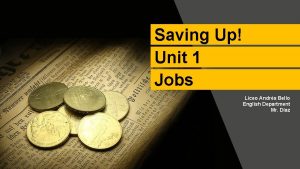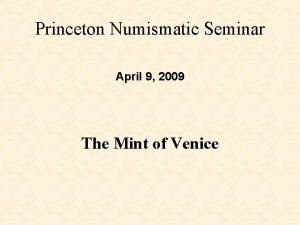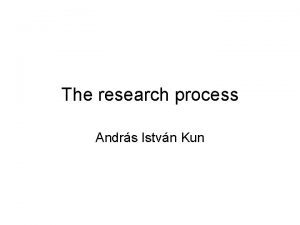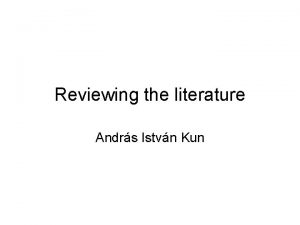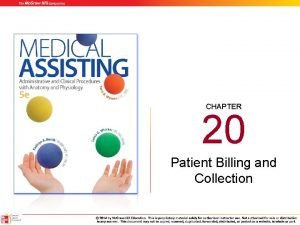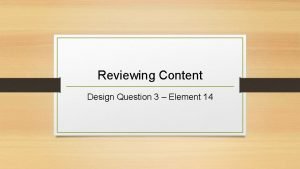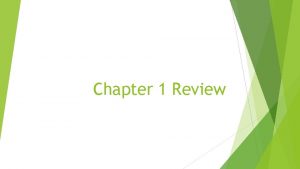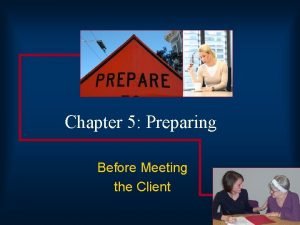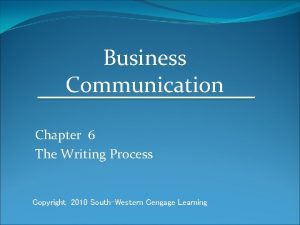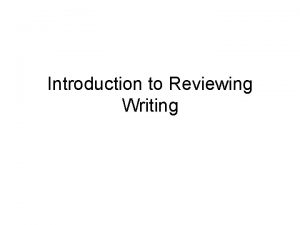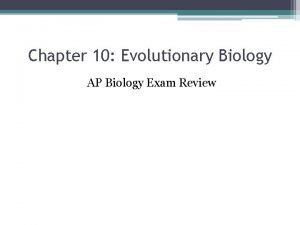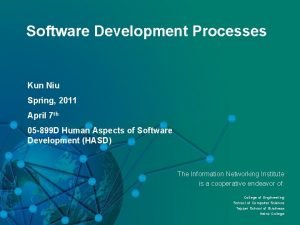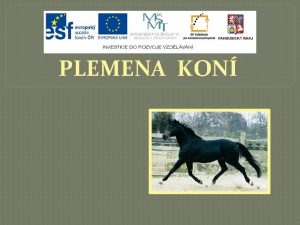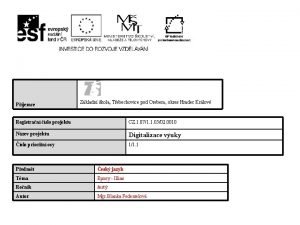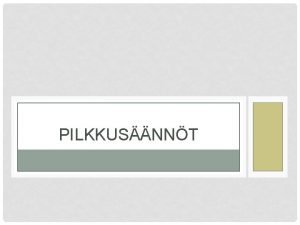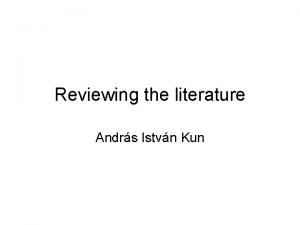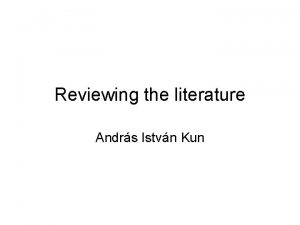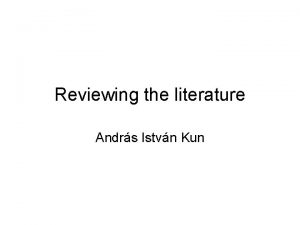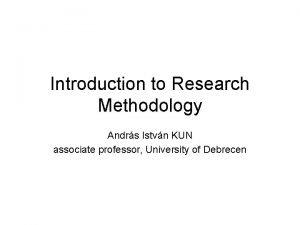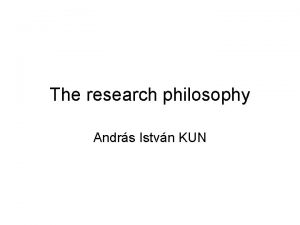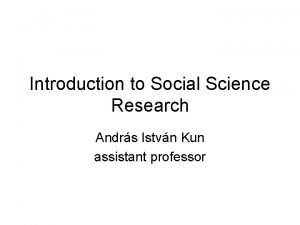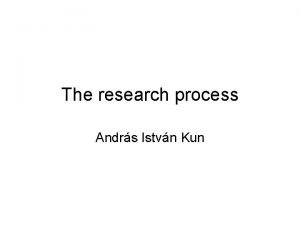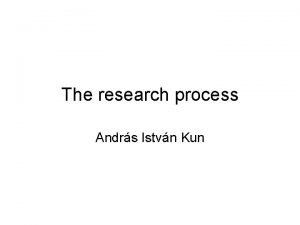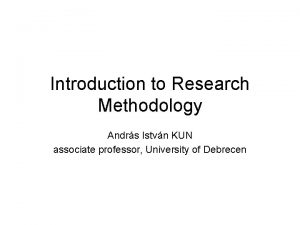Reviewing the literature Andrs Istvn Kun An 8

























- Slides: 25

Reviewing the literature András István Kun

An 8 step model of research processes 0. Identify broad area of research • discipline, school 1. Formulating the research problem (specification) 2. Conceptualising • valid, workable, managable 3. Constructing an instrument for data collection 4. Selecting a sample (sampling) 5. Writing a research proposal • ‘Final’ research questions 6. Collecting data 7. Processing data 8. Writing a report

Cyclic (‘never-ending’) process of research Concepts theory Data analysis Inductive Deductive Research question Empirical data Where is the place of literature reviewing?

Functions of reviewing literature • Knowledge basis • Theoretical background • Help to find a research problem: – What is known and what is unknown – How can you contribute to the existing knowledge body of your profession – Finding the appropriate hyptheses (abduction) • Help to find out what methodology to use – Formal hypotheses, research techniqe, sampling… • Enables you to contextualize your findings

Paradox of literature review • You read to know, but • You have to know what to read (and you have to have some knowledge to understand) • Solution: iterative process of research reviewing

Improving methodology • What are the accepted methodologies • Methodological problems and solutions

Knowledge basis • To some extent it is needed to show the context of your research and your findings • Obligatory chapter of Master and Ph. D theses

5 steps of reviewing literature 1. Search for existing literature in your of study; 2. Review the literature selected; 3. Develop a theoretical framework; 4. Develop a conceptual framework; 5. Writing up the literature reviewed.

Main sources • • Books Journals Grey literature Statistical data

Books • Availability – – Libraries Bookshops Bibliographies (!) Internet: computer catalogs (keywords, subject) • Advantages: greater likelihood of importance, relevance, quality • Disadvantages: not up to date, price, avaliability, quality-control (bibliography!) • They serve best as starters

Journals • Advantages: up-to-date (depends on the journal), area-specific journals • Disadvantages: need more knowledge to understand • They serve best for focused study • Availability: – Libraries – Electronic databases (!) – Internet

Gray literature • Grey literature (or gray literature) is a term used variably by the intelligence community, librarians, and medical and research professionals to refer to a body of materials that cannot be found easily through conventional channels such as publishers, "but which is frequently original and usually recent„ – – – Working papers Theses Company documents Magazines etc.

Quality in research • Whowhat can be qualified? – Researcher – Article – Journal – Institution – Publisher –…

Quality in research (Scientometrics) • The most accepted field of qualification is based on journals. • Academic journals • Referred journals • Peer reviewing • Journal qualification systems – – Based on citation (aim: measuring impact) Rankings Impact factors Hirsch index (h-index), half-life, immediacy – „Page rank”, altmetric score…

An example: ABDC journal quality list • http: //www. abdc. edu. au/ • In 2007, ABDC established an ABDC Journal Quality List to overcome the regional and discipline bias of international lists. • Reviewed in 2013 and 2009. The next major review will be in the second half of 2017. • In 2016: interim review: – – 1) new journals started since 1 January 2011; 2) removal of predatory open access journals; 3) change of Field of Research (Fo. R) grouping; and 4) incorrect factual details - to produce a revised 2016 list.

ABDC journal quality list • The ABDC Journal Quality List 2013 comprises 2, 767 different journal titles, divided into four categories of quality, A*: 6. 9%; A: 20. 8%; B: 28. 4%; and C: 43. 9% journals. • In each Field of Research (Fo. R) group, journals deemed NOT to reach the quality threshold level are not listed.

The Scientific Information (ISI) impact factor (Thomson Reuters) • From 1975 • The journal must be indexed in the Journal Citation Reports • Calculation: – IF for year X = A / B. – A = citations on the citable articles of the journal in years (X-1) and (X-2). – B = total number of the citable articles n a journal in years (X-1) és (X-2). – IF for year X is published in year (X+1). • The sum of the IFs can be used as a quality measure of authors, too.

Highest IF journals by some areas • Economics: JOURNAL OF ECONOMIC LITERATURE, IF: 6. 614 • General management: ACADEMY OF MANAGEMENT REVIEW, IF: 7. 288 • Accounting, finance: JOURNAL OF FINANCE, IF: 5. 290 JOURNAL OF ACCOUNTING & ECONOMICS, IF: 3. 535 • Logistics: TRANSPORTATION RESEARCH PART B: METHODOLOGICAL, IF: 3. 769 SUPPLY CHAIN MANAGEMENT - AN INTERNATIONAL JOURNAL, IF: 2. 731 • http: //www. lib. unideb. hu/hu/adatbazis? b=i • > Impact Factor Social Sciences Edition

Where to start your search • You can search for: – Title – Author – Keyword – JEL classification

Where to start your search • Electronic databases: – lib. unideb. hu (meta search engines) – www. jstor. org – search. epnet. com (EBSCO database) – http: //www. nber. com/ – http: //econpapers. repec. org/ • University pages • Pages of libraries • Library…

Where to start your search • „Social media” for researchers: – academia. edu – researchaget. net – ssrn. com – scholar. google. hu – tudoster. idea. unideb. hu/en

„Publish or Perish” • You are a good researcher if you can prove it through qualified publications. • The role of citations. • Its adverse effects. • The journey of a manuscript to become an article.

Other current trends • Open Access movement • Predatory journals

Referencing • Why? The role of references in research. • When? • How? Systems of referencing. – Author-date sytems: Harvard, APA – Numeric systems: in the text or in the list • Plagiarism

Thanks for your attention
 Andrs bello
Andrs bello Andrs mint
Andrs mint Istvn
Istvn Istvn
Istvn Reviewing the literature
Reviewing the literature Chapter 20 patient collections and financial management
Chapter 20 patient collections and financial management Economic protest parties definition
Economic protest parties definition Reviewing key terms
Reviewing key terms Reviewing key concepts: flatworms, annelids, and roundworms
Reviewing key concepts: flatworms, annelids, and roundworms Reviewing content
Reviewing content Reviewing concepts and vocabulary chapter 1
Reviewing concepts and vocabulary chapter 1 Chloroplast structure and function
Chloroplast structure and function Reviewing key terms
Reviewing key terms Preparatory reviewing
Preparatory reviewing Five main stages of writing business messages
Five main stages of writing business messages What is reviewing
What is reviewing Reviewing key concepts reproductive barriers
Reviewing key concepts reproductive barriers Kun niu
Kun niu Vi har kun en sol
Vi har kun en sol Americký klusák
Americký klusák Epos o dobývání troje
Epos o dobývání troje Franz marc modrý kůň
Franz marc modrý kůň Sorata anime name
Sorata anime name Alisteinen sivulause
Alisteinen sivulause Emma kun
Emma kun Sosiobudaya kerajaan alam melayu
Sosiobudaya kerajaan alam melayu
